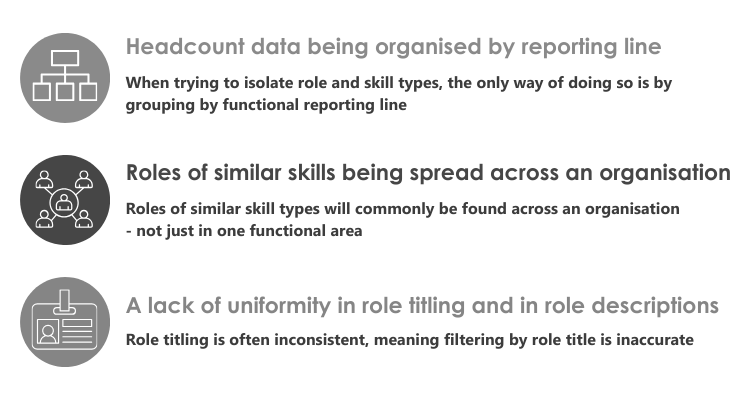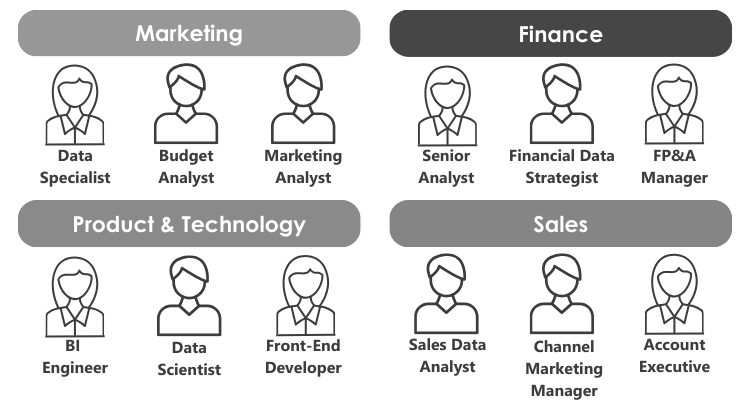Beyond People Data: how a Job Architecture can supercharge skills across your organisation
Even the best people data can’t fully reveal workforce skills. This article explores how a Job Architecture, organising roles by skill and activity, enables better workforce planning, career development, and performance management. Real-world examples show how this framework helps organisations identify gaps, allocate resources, and support employee growth effectively.
Reading time: 5 minutes
Organisations we work with are increasingly realising that a robust understanding of their current skills base is a critical input into planning the execution of their strategy through strategic workforce planning.
Most see the logical place to start as their people data. However, even the most well-maintained, accurate, and detailed people data will provide limited insight to truly assess the skills in your organisation.
To assess skills well requires an overarching structure and framework – one that organises the roles in your organisation according to activity and skill, rather than reporting line.
This article sets out the importance of creating a formal Job Architecture: a multi-purpose role data repository that can be leveraged for strategic workforce planning, as well as career pathway development and performance management.
“A simple solution for an almost universal organisational issue”
The problem with people data
People data is limiting in assessing skills across an organisation due to three fundamental issues:

Roles of similar skills being spread across an organisation is a feature – not a bug – of how organisations deliver. For example, a sales team doesn’t just consist of Account Executives. It contains Sales Enablement, Data Analysts, Channel Marketing, and Administrative roles – all roles that require significantly different skillsets, and all crucial in enabling the Sales division to deliver its objectives. It does, however, make aggregating by skill type across an organisation difficult without a Job Architecture.
The figure below highlights how people data is often set up and organised:

People data set up in this way can make isolating specific roles or skills difficult, giving leaders limited insight into how well the capabilities of their workforce are enabling delivery of strategic goals.
The solution
Organisations that truly understand their roles and skills and use this data to drive decision-making more often than not have a formal Job Architecture in place.
A Job Architecture puts a structure around people data based on skills and activities, rather than functional reporting. It does this by creating a catalogue of Job Roles: roles that represent all the positions in an organisation, and grouping these Job Roles into Job Families and Functions. The Job Families and Functions are skill-based, meaning all roles of similar skills are mapped to the same group.
The below graphic gives an example of how a Job Architecture could be applied to the people data shown above. The roles with Data & Analytics skills, otherwise spread across the organisation, are mapped to Job Roles all within the Data & Analytics job family.

Once set up, organisations can quickly view the level of FTE and cost attributed to each Job Role, Function, and Family, giving a clear understanding of which skillsets investment needs to go into, as well as where it doesn’t.
As new roles are hired, each should then be mapped to the Job Architecture framework, ensuring standardisation and providing an up-to-date baseline to drive strategic decision-making.
A case study
When COVID hit, a client in the media sector was faced with a problem of needing to quickly backfill on-set production roles as staff had to go on sick leave. To do this, there was a need to create a database across the organisation of all the roles with production capabilities.
With no formal Job Architecture in place, this meant sending out individual spreadsheets to all program teams to understand the extent of production capability in these teams. This was completed inconsistently, was quickly out of date and ultimately not fit for purpose.
In light of this, the client engaged Q5 to set up a formal Job Architecture to map all production roles to a Job Role, within a ‘Production’ Job Family. This then led to the creation of an enterprise-wide Job Architecture which, once completed, made identifying the correct roles for backfill simple and quick.
Over the course of the program, 4,000+ individual roles were mapped to 200 Job Roles and grouped into 57 Job Functions and 15 Job Families. Not only did this support with the backfill problem, it created a robust and standardised role framework for the organisation to use going forward.
Job Architecture as a public document
Whilst people data is sensitive and can rarely be shared, a Job Architecture can be. When used correctly, it provides employees and managers with a powerful tool to enable career and succession planning. The Architecture framework can provide employees with a better understanding of the skills required for their roles and other roles within the same or similar Job Functions / Families to theirs if they have aspirations to move into that role in the future.
This broadens the scope of internal moves for employees, and serves as a useful tool in career, performance management and training conversations between employees and managers.
Using job architecture to anticipate future needs
Once organisations have a widely understood and rigorous assessment of existing skills, they have a solid foundation from which to understand what skills they need to develop in the future, and what may be surplus to requirements to deliver their strategy effectively.
To explore how a Job Architecture can be a catalyst to ensuring your organisation has the right skills across the right roles to meet your strategic objectives please contact us.
We are all about organisational health, which separates good organisations from the great. Whether our clients are at the top of their game (and want to remain there) or are in ‘turnaround’ mode, we all need to work on our organisational health.
Whatever the situation, be it a strategic conundrum, a market opportunity, or an operational gripe, we combine the art and science of organisational health to help our clients improve and excel.
Please visit the firm link to site



